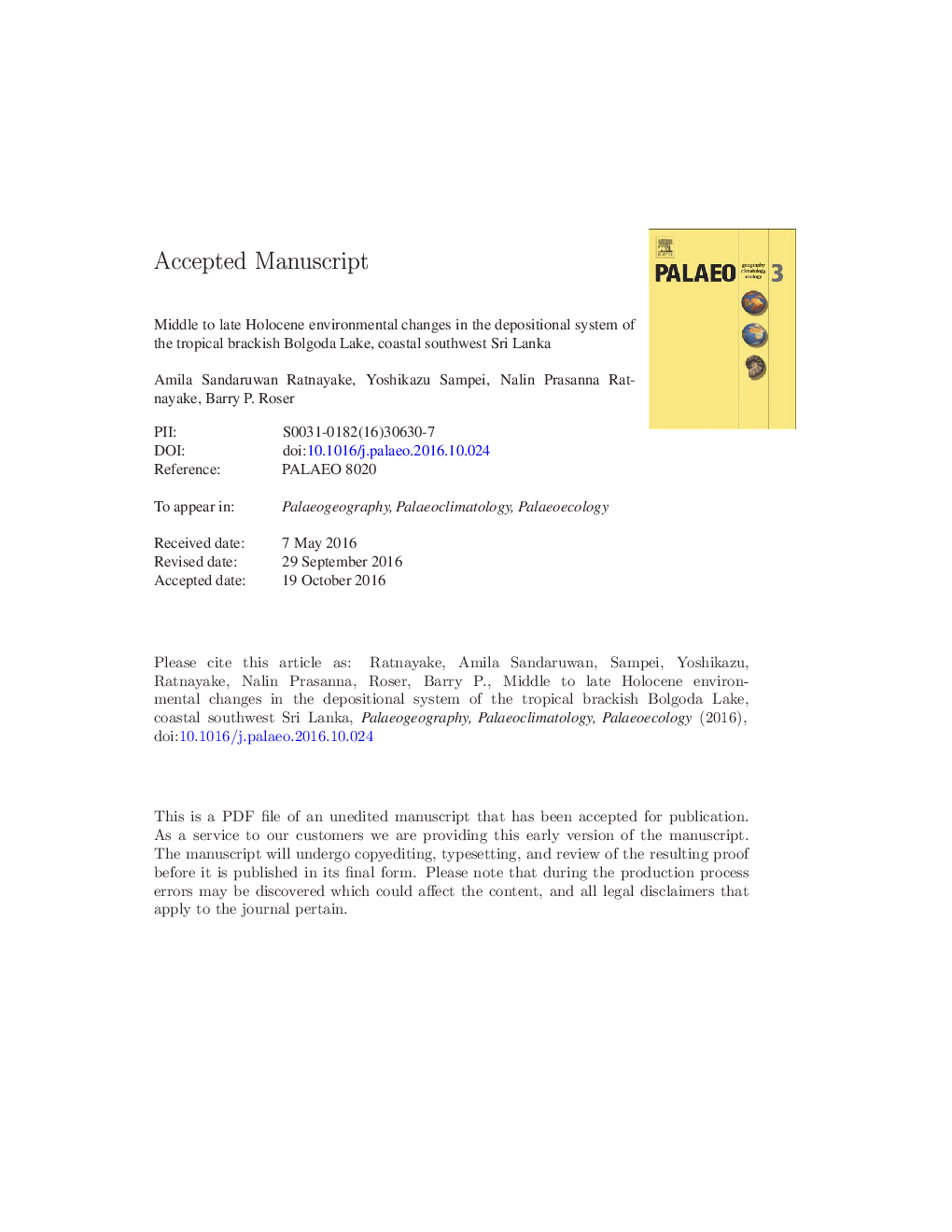| کد مقاله | کد نشریه | سال انتشار | مقاله انگلیسی | نسخه تمام متن |
|---|---|---|---|---|
| 5756000 | 1412697 | 2017 | 51 صفحه PDF | دانلود رایگان |
عنوان انگلیسی مقاله ISI
Middle to late Holocene environmental changes in the depositional system of the tropical brackish Bolgoda Lake, coastal southwest Sri Lanka
دانلود مقاله + سفارش ترجمه
دانلود مقاله ISI انگلیسی
رایگان برای ایرانیان
کلمات کلیدی
موضوعات مرتبط
مهندسی و علوم پایه
علوم زمین و سیارات
فرآیندهای سطح زمین
پیش نمایش صفحه اول مقاله

چکیده انگلیسی
The tropical Bolgoda Lake is one of the largest lagoonal estuaries in Sri Lanka. Organic constituents in this lake were investigated using 28 surface sediments, three cores from the lake, and four short cores from mangrove mud. Elemental and molecular compositions of sediments and living organic matter (OM) were determined using CNS elemental analysis and gas chromatography-mass spectrometry, respectively. Chronology of events was determined using accelerated mass spectrometry (AMS) 14C data for bulk OMs, woods and mollusk shells. The history of Bolgoda Lake can be divided into two major chrono-stratigraphic divisions, namely a lower sedimentary succession (from ca. 7.0 cal ky B.P. to 2.5 cal ky B.P.) and an upper sedimentary succession (from ca. 2.5 cal ky B.P. to the Recent), according to the sapropelic depositional system. Concentrations of the mangrove biomarker taraxone increased significantly at ca. 7.0 cal ky B.P. The lower part of the sediment sequence had moderate productivity, and was mainly deposited under marine-terrestrial influence in oxygen-poor/anoxic conditions during mid-Holocene sea-level highstands. A drastic increase in total organic carbon (TOC) content, reaching 29%, was found in one of the Bolgoda cores. This increase occurred because of sea-level regression at about 2.5 cal ky B.P. This change was probably caused by development of a beach rock/sandbar, and the estuary system changed to a semi-closed lake due to the sea-level regression. As a result, aquatic vascular plants predominate in this depositional system. After ca. 2.5 cal ky B.P., TOC content decreased slightly, but relatively high TOC contents were maintained in the muddy sediments. In moderately-sized and shallow (1-2 m) tropical estuaries/lagoons such as Bolgoda Lake, drastic changes in TOC contents may be the most sensitive indicator of sea-level variations. Increase in higher plant OM with higher n-C29/n-Call and n-C37/n-Call alkane ratios also suggest a climatic transition from wetter to somewhat drier after the middle Holocene. Accumulations of pyrogenic polycyclic aromatic hydrocarbons (PAHs) in the modern sediments record anthropogenic activity after European settlement in the 15th century.
ناشر
Database: Elsevier - ScienceDirect (ساینس دایرکت)
Journal: Palaeogeography, Palaeoclimatology, Palaeoecology - Volume 465, Part A, 1 January 2017, Pages 122-137
Journal: Palaeogeography, Palaeoclimatology, Palaeoecology - Volume 465, Part A, 1 January 2017, Pages 122-137
نویسندگان
Amila Sandaruwan Ratnayake, Yoshikazu Sampei, Nalin Prasanna Ratnayake, Barry P. Roser,